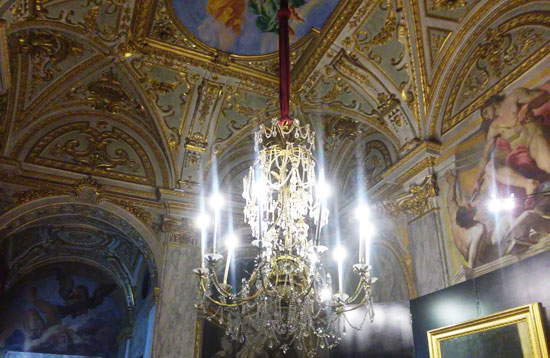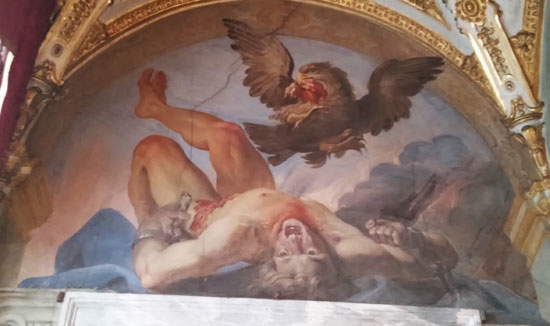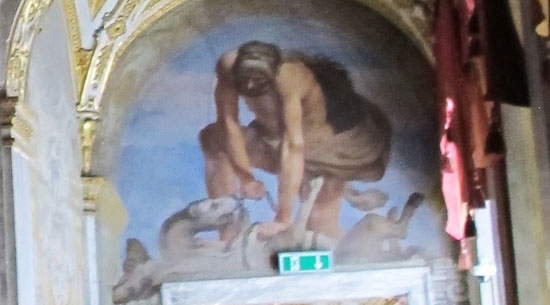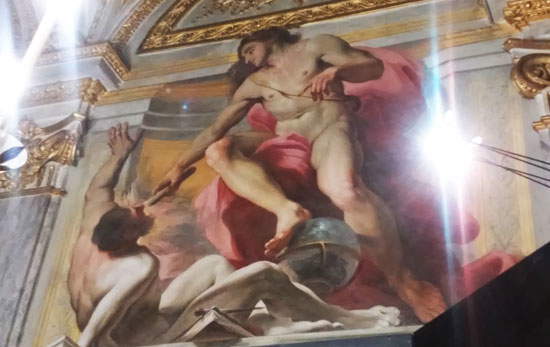Also by this Painter, and of his most specious frescoes, are those which stand out above the doors leading to the gallery in the palace of the Most Excellent Marcello Durazzo of the late Gio.Luca: and they represent Prometheus, who animates man; Hercules, who breaks down the hydra; and Titius, whose heart is devoured by the vulture. Thelatter is a figure so vivid, and of such force of expression, that it startles those who affix themselves to it. The passage is taken from the 18th-century edition of the Lives of Genoese Painters, Sculptors and Architects, begun by Raffaele Soprani (Genoa, 1612 - 1672) and continued by Carlo Giuseppe Ratti (Savona, 1737 - Genoa, 1795) with a second tome published in 1769. The “Painter” referred to is Giovanni Andrea Carlone (Genoa, 1639 - 1697), and the “Palazzo dell’Eccellentissimo Marcello Durazzo del fu Gio.Luca” is the one currently known as the Royal Palace. We are, of course, in Genoa. The frescoes of which Ratti speaks are those that decorate the Chapel Gallery: we decided to talk about them because they represent a very special case of the late Genoese Baroque, and because they are among the most magnificent and impressive of all those that make up the sumptuous scenographic apparatus of a palace with a centuries-long history, which was owned by various families whose choices and tastes can be discerned in every single room. From the theatrical finery of the Balbi through the charged and magniloquent taste of the Durazzo to the regal solemnity of the Savoy. Giovanni Andrea Carlone’s frescoes were painted, as Ratti recalls, when the building was owned by the Durazzo family, which purchased it in 1679 and within a short time promoted the expansion of the palace with the construction of the east wing and, later, the Galleria degli Specchi and the terrace that provides a splendid view of Genoa’s harbor.
 |
| The Chapel Gallery in the Royal Palace of Genoa |
The tour route of the Royal Palace leads to visit first the Mirror Gallery and then the Chapel Gallery: thus, those arriving from the Mirror Gallery will immediately find before their eyes, on the opposite wall of the room, the fresco with the torment of Titius. That is, the one with the strongest impact, so much so that it is the only one of the three episodes to have earned the commentary by Carlo Giuseppe Ratti. The scene, strongly foreshortened to give us the impression that we are really in the place where the mythological hero is undergoing his tremendous torment, shows us the protagonist, Titius, tied to a cliff by heavy chains, while furious and desperate, with a terrible expression manifesting itself through a cry of extreme suffering deforms his face, he writhes in pain caused by the vulture that opens his chest to devour his internal organs (for some variants of the myth the heart, for others the liver). What had this character, according to tradition a giant born from the union of Zeus and Elara, done to deserve such atrocious torture? He had had the audacity to undermine Latona, Zeus’s lover: Hera, wife of the ruler of the gods, harbored a strong jealousy, and had incited Titius to the point of inducing him to feel this insane passion for the titanid object of Zeus’s attentions. An insane passion resulted in an attempt at violence: discovered, the giant was condemned to torture, although the different versions of the story do not agree on who was the originator of the punishment.
 |
| Giovanni Andrea Carlone, The Torture of Titius (c. 1694; fresco; Genoa, Royal Palace, Chapel Gallery) |
The frescoes would all be related to the theme of divine justice, as suggested by the fresco in the vault, which depicts Astrea, a deity associated with justice, before Jupiter: the work is by Giovanni Andrea’s father, namely Giovanni Battista Carlone (Genoa, 1603 - c. 1684), who painted it around 1655. Moreover, according to a hypothesis put forward recently, on the occasion of the major exhibition on Valerio Castello in 2008, by art historian Camillo Manzitti (among the leading experts on 17th-century Genoese art), the fresco with Hercules binding Cerberus (and not the Hydra, as Ratti writes in the second tome of the Lives) should also be attributed to Giovanni Battista’s hand: the comparison was made on a stylistic basis and would therefore place the execution of the painting around the date of the fresco in the vault. That is, about forty years before Giovanni Andrea’s frescoes, which were made around 1694. The episode depicts the last of the twelve labors of Hercules, the series of exploits that the mythological hero had decided to undertake in order to atone for his sins (he had in fact killed his wife and children in a terrible access of insane anger provoked by the goddess Hera). In the scene, the painter depicts the hellish dog along the entire bottom edge of the composition, parallel to the door frame, while Hercules is intent on holding it down with his left hand and pulling, with his right, the rope to bind it. Again, this is a work that strikes the viewer: the expedient of depicting Cerberus along the frame, as he furiously struggles and with one of his three heads attempts to reach Hercules’ arms, makes one feel a participant in the scene, almost as if it were unfolding above our heads.
 |
| Giovanni Andrea Carlone or Giovanni Battista Carlone, Hercules Ties Cerberus (c. 1694 or c. 1655; fresco; Genoa, Royal Palace, Chapel Gallery). Credit |
The episode that appears on the central wall presents us with the titan Prometheus as, with his flashlight fueled by divine fire, he breathes life into man: that of Prometheus is a tragic figure, as well as among the most beloved in mythology as a hero who is a friend of humanity and opposed to the inflexible authority of the Olympian gods. In fact, Prometheus, after creating man, stole the divine fire to give it to humanity from whom Jupiter had taken it away. For this, again according to the myth, the titan met with an atrocious divine punishment, similar to that of Titius: Prometheus was also condemned to be tied to a rock and to have his liver devoured, every day, by an eagle. Giovanni Andrea Carlone, in line with the most spectacular Baroque tendencies, has the gigantic figure of Prometheus, who arrives carried by a large veil lifted by the wind, emerge from the space of the mock niche within which he is supposed to be placed, so that his head protrudes beyond the cornice: an expedient used to increase the illusionistic effect of the representation. Again, the figure of the first man, animated by Prometheus, is placed along the lower edge of the composition: we see how the divine flame also brightens the color of the complexion to suggest to the viewer how the man is receiving the gift of life. Moreover, given the similarity of the two torments, art historian Ezia Gavazza has advanced the hypothesis that the scene on the exit wall of the room must be, precisely, that of Prometheus’ torment, and that all three episodes are connected to the myth of the titan (Hercules was, in fact, his liberator).
 |
| Giovanni Andrea Carlone, Prometheus Animates Man (ca. 1694; fresco; Genoa, Royal Palace, Chapel Gallery) |
We know little about these frescoes, however: what is certain is that this crude and brutal theatricality represents almost a unicum for seventeenth-century fresco decoration in Genoese palaces, since the families of the city’s nobility were oriented toward more sedate scenes. Here, the huge figures, their expressions full of pathos and their sweeping gestures create bewilderment in the viewer of the paintings: “the grim appearance of that Tizio is not a thing to please gentle eyes and in so worthy a place,” wrote the 19th-century Genoese historian Federico Alizeri, in his Guida artistica alla città di Genova, about the most terrible of the scenes in Giovanni Andrea Carlone’s cycle. And in the same text, Alizeri wrote that, according to someone who had reported to him, the idea had been proposed of commissioning one of the most prominent Genoese painters of the nineteenth century, Giuseppe Isola, to paint pictures “of a happier subject” with which to conceal Carlone’s frescoes. But fortunately the works were not hidden: any covers would have kept many visitors unaware of one of the most unique inventions of the entire late Genoese Baroque.
Reference bibliography
Warning: the translation into English of the original Italian article was created using automatic tools. We undertake to review all articles, but we do not guarantee the total absence of inaccuracies in the translation due to the program. You can find the original by clicking on the ITA button. If you find any mistake,please contact us.